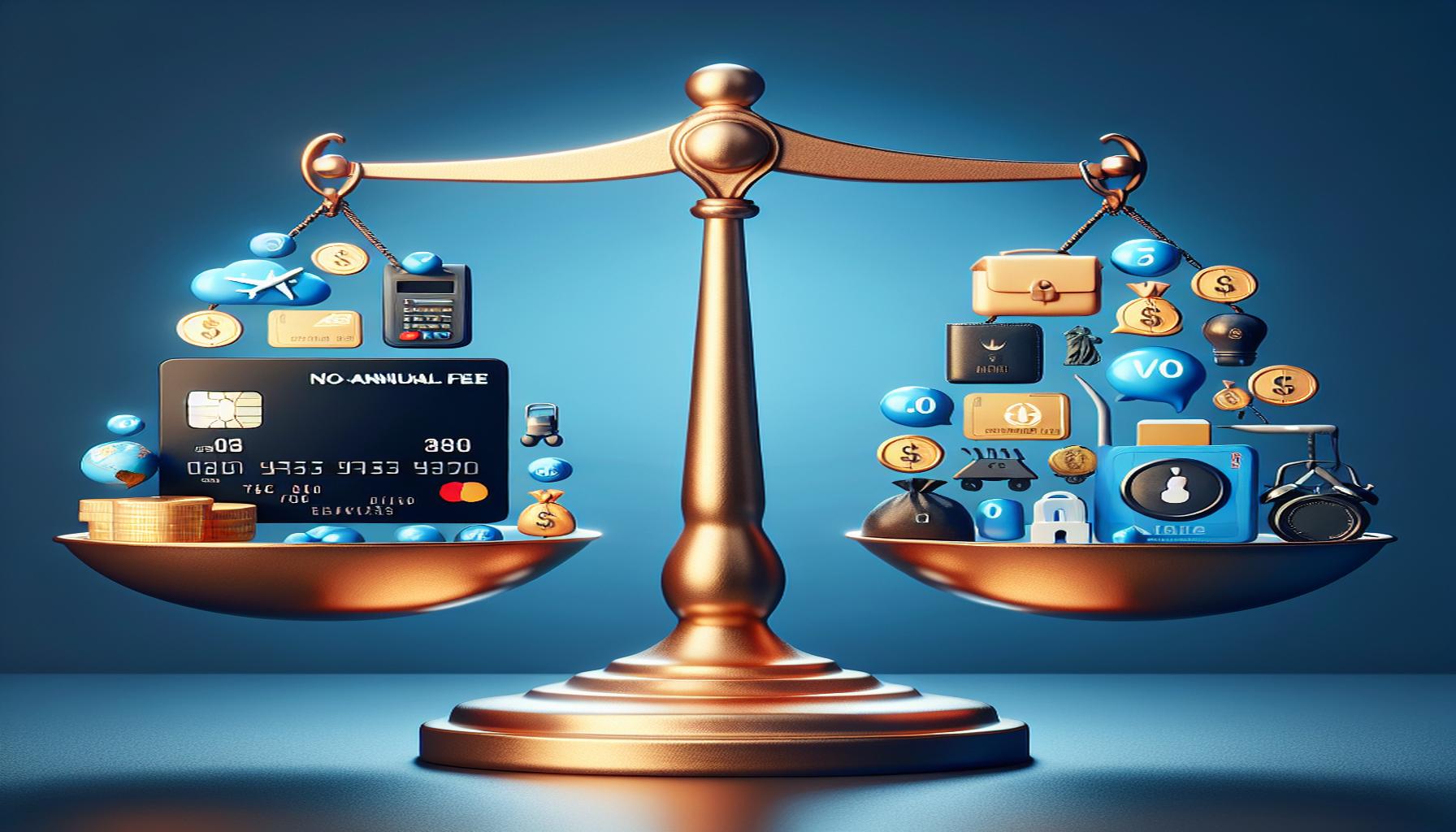Advantages and disadvantages of no-annual-fee credit cards

Understanding No-Annual-Fee Credit Cards
No-annual-fee credit cards have gained popularity among Australian consumers due to their appealing features. These cards allow you to access credit without the added cost of an annual fee, making them an attractive option for many. However, it’s essential to weigh the advantages and disadvantages before deciding if this type of card is right for you.
Key Advantages
- No Cost: The primary benefit of no-annual-fee credit cards is the absence of an annual fee, which can significantly save you money over the year. For instance, if you choose a card that typically charges a fee of $100 a year, opting for a no-annual-fee card means you essentially keep that money in your pocket, giving you more flexibility in your budget.
- Flexible Use: These cards can be used for everyday purchases such as groceries, dining, and petrol, without the concern of fees piling up. For example, if you regularly fill your car with fuel or dine out a few times a month, using a no-annual-fee card could make these expenses easier to manage without incurring extra costs.
- Building Credit: Using a no-annual-fee card responsibly can be a great way to build or improve your credit score over time. Making timely payments and keeping your credit utilization low are key factors that contribute to a positive credit history. For instance, if you charge $500 a month to your card and pay it off in full, you can enhance your creditworthiness, which is beneficial for future loans or mortgages.
Potential Disadvantages
- Limited Rewards: One common drawback of many no-annual-fee cards is that they offer fewer rewards points compared to premium cards. For example, while a premium card might reward you with 2 points per dollar spent, a no-annual-fee card might only offer 1 point per dollar. This could mean missing out on substantial benefits if you frequently travel or make large purchases.
- Higher Interest Rates: You may face higher interest rates with no-annual-fee cards, which can be costly if you tend to carry a balance. If a card has an interest rate of 20% and you carry over a $2,000 balance, the accruing interest can be significant, quickly outweighing the savings from not paying an annual fee.
- Limited Benefits: These cards often lack additional perks commonly offered by more premium options, such as travel insurance, concierge services, or exclusive access to events. For example, if you travel often, missing out on travel insurance could expose you to unexpected costs in case of trip cancellations or delays.
Understanding these factors will aid you in making informed financial decisions. Carefully evaluate how a no-annual-fee credit card fits into your personal finance strategy and consider your spending habits and how you manage credit. By weighing both the pros and cons, you can choose a card that aligns with your financial goals, ensuring that it benefits your lifestyle without adding unnecessary costs.
Assessing the Benefits and Drawbacks of No-Annual-Fee Credit Cards
No-annual-fee credit cards come with a variety of benefits that can make them very appealing to consumers, especially for those who want to avoid unnecessary costs. Understanding these advantages can help you decide if this type of card is suitable for your financial situation.
Key Advantages
- No Cost: The most significant advantage of no-annual-fee credit cards is the fact that there are no yearly fees to worry about. This can lead to substantial savings over time. For example, letting go of a standard $100 annual fee can mean extra cash that you can direct toward savings or other expenses. This can make a big difference, especially for someone on a tight budget.
- Flexible Use: No-annual-fee cards provide a convenient way to manage daily purchases without the pressure of accumulating fees. Imagine using the card for your weekly grocery shop or for quick trips to the coffee shop—all without worrying that frequent use will result in a hefty yearly fee. It makes everyday spending easier and more manageable.
- Building Credit: A no-annual-fee credit card can help you build or improve your credit score, particularly if used wisely. Making consistent, on-time payments and maintaining low balances can positively impact your credit history. For instance, if you typically spend $300 a month and pay it off entirely each month, you are likely to see a boost in your credit score over time, which is critical when applying for loans or mortgages in the future.
Potential Disadvantages
- Limited Rewards: One key drawback of many no-annual-fee credit cards is that they might offer limited rewards or points compared to premium credit cards. For example, while a premium credit card could earn you 2 points for every dollar spent on travel, a no-annual-fee card might only offer 1 point for the same expenditure. This can lead to missed opportunities for benefits if you frequently travel or enjoy shopping, as you may not accrue rewards as quickly.
- Higher Interest Rates: Another concern with no-annual-fee credit cards is that they often come with higher interest rates than their premium counterparts. If you don’t pay your balance in full each month, the cost of interest can quickly erode any savings from avoiding annual fees. For example, if the card’s interest rate is 20% and you carry a $1,000 balance, the interest can add up dramatically, making it more costly than it first appears.
- Limited Benefits: No-annual-fee cards tend to lack the additional perks and benefits that premium cards provide, such as travel insurance, purchase protection, or exclusive discounts. If you’re someone who travels frequently, for instance, missing out on complimentary travel insurance can be a significant disadvantage, potentially leading to unexpected expenses if you encounter delays or cancellations.
Considering these advantages and disadvantages will empower you to make informed choices about whether a no-annual-fee credit card aligns with your financial habits and objectives. By carefully evaluating your spending patterns and credit management strategies, you can select a card that meets your needs without incurring unnecessary costs.
Weighing the Impacts of No-Annual-Fee Credit Cards on Financial Health
In addition to the key advantages and disadvantages previously mentioned, there are several other factors to consider when evaluating no-annual-fee credit cards. These cards can play a significant role in your overall financial health and consumer experience.
Additional Advantages
- Easy to Cancel: Another advantage of no-annual-fee credit cards is that they can be easier to cancel without any financial loss. If your needs change, or if you find a card that better fits your lifestyle, you won’t be reluctant to cancel a card that charges an annual fee. This flexibility allows consumers to switch cards more freely, adapting to their evolving financial goals.
- Encourages Responsible Spending: No-annual-fee cards can encourage responsible spending practices. Since there is no cost attached to holding the card, many individuals find it easier to track their purchases without the pressure of generating annual fees. This approach can promote budgeting and awareness of spending habits, especially for first-time credit card users who are learning to manage their finances.
- Option for Building a Credit Portfolio: For those just starting their credit journey or for individuals looking to rebuild their credit score after financial difficulties, no-annual-fee credit cards can serve as an invaluable tool. They provide an opportunity to diversify your credit portfolio without incurring high fees. For example, if you already have a low-interest personal loan, adding a no-annual-fee credit card can improve your credit mix, which is a factor lenders consider when evaluating creditworthiness.
Additional Disadvantages
- Potential for Fewer Financial Protections: While no-annual-fee credit cards may present some useful features, they often do not offer the same level of consumer protection as premium options. Many high-end cards come with features such as fraud monitoring services, identity theft protection, and rental car insurance. Without these added layers of financial security, users may find themselves more exposed to risks, especially in situations involving high-value transactions.
- Introductory Offers May Fall Short: Some no-annual-fee cards provide enticing introductory offers, such as bonus points for new users. However, these offers may not be as generous or rewarding compared to those provided by premium cards. For instance, a no-annual-fee card might offer a modest bonus after spending a set amount, while a premium card could offer significant travel rewards or cash back bonuses, enhancing the overall value of the card.
- Poor Customer Service Quality: Customers have reported that no-annual-fee credit cards sometimes come with lower levels of customer service compared to premium options. This disparity can lead to frustration when dealing with issues, such as disputed charges or obtaining account information. For instance, if a cardholder encounters a problem and requires assistance, they may face longer wait times or less personalized support than they would receive from a premium credit card issuer.
When contemplating the benefits and drawbacks of no-annual-fee credit cards, it is essential to take into account your spending habits, financial objectives, and overall credit use strategies. Understanding both the advantages and disadvantages may empower consumers to select a credit card that aligns with their financial goals while also considering the cost and benefits structure of the card itself.
Final Thoughts on No-Annual-Fee Credit Cards
In conclusion, no-annual-fee credit cards can be a double-edged sword for consumers. On one hand, they provide a way to manage spending and build credit without the burden of yearly fees, making them appealing for individuals looking to maintain a budget. Their flexibility in cancellation also offers consumers the liberty to adjust their credit strategies in response to changing financial needs. Furthermore, as a stepping stone for those new to credit or those seeking to improve their credit scores, these cards can serve as valuable tools.
However, it’s essential to recognize the potential downsides. The absence of annual fees often comes at the cost of fewer premium features and less robust customer service. Many no-annual-fee cards lack comprehensive fraud protection or attractive introductory offers, which can limit their value in the long run. Therefore, it is crucial for consumers to scrutinize the card’s terms, rewards program, and available protections before making a decision.
Ultimately, your choice should align with your unique financial situation, goals, and spending habits. By weighing the advantages and disadvantages thoroughly, you can select a credit card that not only meets your immediate needs but also contributes positively to your overall financial health. Remember, what may work for one individual may not be suitable for another, so take your time to evaluate all options carefully.

Linda Carter is a writer and financial expert specializing in personal finance and financial planning. With extensive experience helping individuals achieve financial stability and make informed decisions, Linda shares her knowledge on the Take Care Garden platform. Her goal is to empower readers with practical advice and strategies for financial success.





